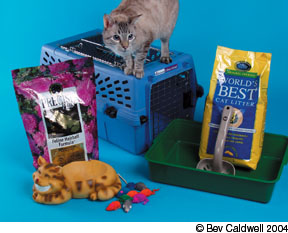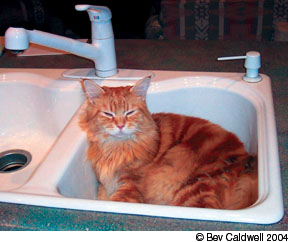Are you thinking of adopting an animal companion of the feline variety? Oh, the joys to be had! But there are also many decisions to be made. Plan, prepare and prevent – these are the three Ps of bringing a new member into the family. Planning ahead and preparing for the new arrival can go a long way toward preventing problems that might cause you to regret your decision.
A Plan of Action
Whether its an adult cat or a kitten, you might think, Im bringing home a small, furry, four-legged critter – whats to plan? According to Jim Tantillo, executive director of the Tompkins County SPCA, theres actually plenty to consider. From the cost of adoption and scheduling follow-up veterinary visits, to where he or she will sleep and what he or she will eat, there are plenty of reasons to plan ahead.
Tantillo reminds future caregivers that all cats and kittens need loving homes. Therefore, private adoptions are just as important as shelter adoptions. When adopting from a private residence there are some things a caregiver will need to plan for, such as a visit to their own veterinarian within a few days of the adoption for a complete physical and immunizations.
Cats and kittens adopted from a shelter have usually been started on the road to good health, Tantillo says. The first things we do after taking in an animal, explains Tantillo, include checking for ear mites and for respiratory infections, treating illnesses as needed and giving all necessary vaccines. Besides the basic healthcare screening, felines are usually spayed or neutered before leaving a shelter.
Everyone who adopts an animal is instructed to take his or her new companion to the veterinarian within two weeks of the adoption. This will put the animal on schedule for future vaccines and check-ups as needed, says Tantillo.
Planning also includes financial awareness: What will this decision cost? A shelter adoption can range from $100 to $150 depending on the shelter, says Tantillo. And then there are follow-up visits and immunizations to plan for. And while there may be no fee for private adoptions, there is the cost of the initial check-up plus vaccinations, diagnostic tests (like for feline leukemia virus and feline immunodeficiency virus), treatment for any unforeseen illness, and the cost of spaying or neutering.

288
How to Prepare
Cats need time to adjust to their new environment, says Tantillo. Be sure to have a quiet room where they will feel safe. Once home, let the cat out of the carrier and give him plenty of time to explore and acclimate to his new surroundings. Your cat may hide for a few days (or even weeks) under beds or in closets, which is quite normal; you need to give him time to come out on its own.
Be cautious with your new feline companion and children, Tantillo advises. A skittish cat may react by scratching. This doesnt mean he is vicious; it means he is scared. Be careful not to provoke this frightened response in the first place.
Starting off on the right foot with litter box handling will reduce the chances that problems will develop later on. Taking some simple steps will increase the likelihood of successful litter box training. Place the box in an area where the cat has easy access, keep it clean by scooping it once or twice a day and clean it completely every week.
Litter box training is essential to ensuring a positive experience as a cat owner.
Housesoiling is the number one reason why caregivers seek the advice of a behavior therapist, says Wayne Hunthausen, DVM, an animal behavior consultant at Westwood Animal Hospital in Westwood, Kansas. Inappropriate elimination usually happens when there is something wrong with the litter box or there is a stronger attraction to other surfaces or areas around the home.
If your new companion does not use his or her litter box, Dr. Hunthausen suggests trying a different type of litter or a different type of box. (Hint: Many cats dont enjoy using covered litter boxes or scented litter.) You should clean the box thoroughly to make sure there are no unpleasant disinfectant odors and locate the box in a quiet, secluded area away from foot traffic and household noise.
What will you feed your new companion? Dry food or canned? Adult food or kitten food? What about bones and table scraps? Just remember, what goes in must come out, is the advice Tantillo offers about what to feed your companion. What they eat affects elimination. While dry food versus canned food is a personal decision, Tantillo simply recommends that you choose a premium-grade food, and, in the case of a specific health-related issue, a diet recommended for that particular issue.
Talk to your veterinarian about special needs and feed accordingly, says Tantillo. He also advises that you make no abrupt shifts in your cats diet. If possible, continue to feed your adopted pet the same food it has been eating. Avoid feeding table scraps and leave plenty of clean water out all the time.

288
When adopting from a shelter, new caregivers are often sent home with the brand of food that the cat has been eating. When adopting from a private residence, ask what your feline companion is used to eating so you can buy the same brand. Perhaps the people in that household will give you enough to last until you can find a supplier. It is best if changes in diet take place gradually, says Tantillo.
Should you let your cat go outdoors or keep him indoors? This is a question that new caregivers often ponder. Safety is the key factor to consider. Being allowed to investigate the great outdoors is something that many cats enjoy; they love to explore.
But safety can rarely be assured for cats allowed free outdoor access.The best solution is to find ways to keep him entertained and happy while living an indoor life. Provide plenty of toys and a scratching post, and provide lots of entertainment. If out-of-doors excursions are allowed, they should always be under your supervision or in a safe, enclosed area.
Prevention is Best
Planning and preparing for acclimation, veterinary visits (time and expense), litter box training, play time, nutritious food and protection if allowed outdoors and entertainment when indoors will help prevent illness and disease, injury, boredom and housesoiling problems. Proper planning and preparation will help prevent a number of unfavorable outcomes and should pave the way to a happy, healthy, lifelong relationship.



